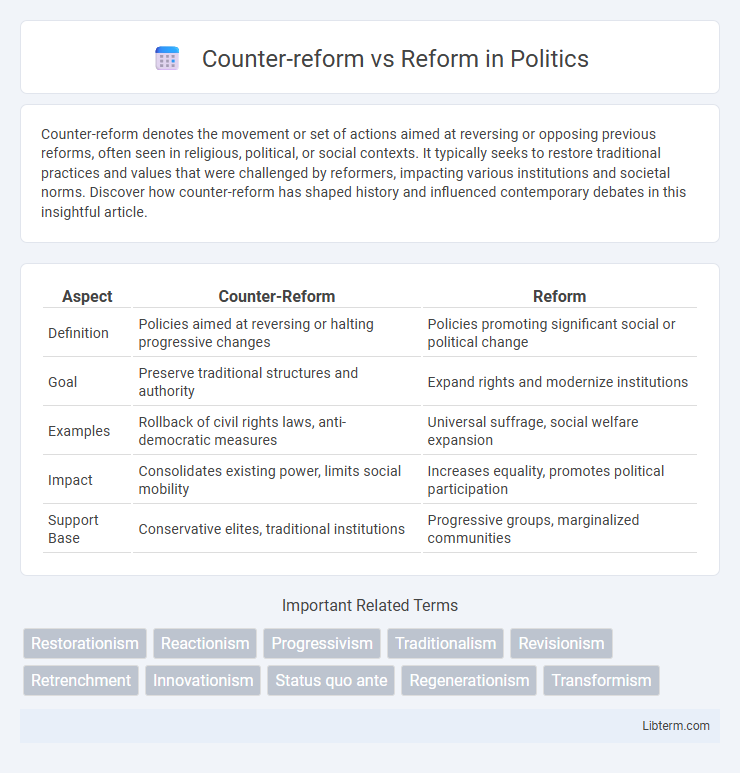Counter-reform denotes the movement or set of actions aimed at reversing or opposing previous reforms, often seen in religious, political, or social contexts. It typically seeks to restore traditional practices and values that were challenged by reformers, impacting various institutions and societal norms. Discover how counter-reform has shaped history and influenced contemporary debates in this insightful article.
Table of Comparison
| Aspect | Counter-Reform | Reform |
|---|---|---|
| Definition | Policies aimed at reversing or halting progressive changes | Policies promoting significant social or political change |
| Goal | Preserve traditional structures and authority | Expand rights and modernize institutions |
| Examples | Rollback of civil rights laws, anti-democratic measures | Universal suffrage, social welfare expansion |
| Impact | Consolidates existing power, limits social mobility | Increases equality, promotes political participation |
| Support Base | Conservative elites, traditional institutions | Progressive groups, marginalized communities |
Introduction to Counter-Reform and Reform
Reform refers to deliberate changes aimed at improving political, social, or religious systems by addressing perceived injustices or inefficiencies. Counter-Reform, often associated with the Catholic Church's response to the Protestant Reformation, sought to reaffirm traditional doctrines, reform internal abuses, and combat the spread of Protestantism during the 16th century. Both movements significantly influenced European history by shaping religious, cultural, and political landscapes.
Historical Context of Reform Movements
Reform movements historically sought to address social, political, and economic inequalities through progressive changes, as seen in the 19th-century abolitionist and suffragist campaigns that aimed to expand rights and justice. Counter-reforms emerged as reactionary measures intending to preserve traditional institutions and power structures, often resisting reforms linked to secularization or democratization, exemplified by the Catholic Church's opposition during the Protestant Reformation. The dynamic between reform and counter-reform thus reflects broader societal struggles over modernization, authority, and cultural identity throughout history.
Origins and Motivations Behind Counter-Reform
The Counter-Reform, also known as the Catholic Reformation, originated in response to the Protestant Reformation's challenge to Catholic doctrine and authority in the early 16th century. Motivated by the need to address corruption, clarify church teachings, and reaffirm papal power, it aimed to restore the Church's spiritual integrity and influence. Key figures like Ignatius of Loyola and the Council of Trent played critical roles in defining Counter-Reform policies and revitalizing Catholicism across Europe.
Key Players in Reform and Counter-Reform
Key players in the Reform movement included Martin Luther, John Calvin, and Huldrych Zwingli, whose theological critiques challenged the Catholic Church's doctrines and practices, sparking widespread religious and social change. In contrast, the Counter-Reform, led by figures such as Pope Paul III, Ignatius of Loyola, and the Council of Trent, aimed to reinforce Catholic doctrine, reform internal church corruption, and combat Protestant growth. The dynamic conflict between these leaders shaped the religious landscape of Europe, influencing politics, culture, and ecclesiastical authority.
Strategies and Tactics: Reform vs. Counter-Reform
Reform strategies typically leverage grassroots mobilization, policy advocacy, and institutional restructuring to implement progressive changes aligned with social justice and equity. Counter-reform tactics emphasize preserving existing power structures through legislative rollbacks, strategic litigation, and propaganda campaigns aiming to limit or reverse reforms. Effective movements often adapt by blending grassroots activism with savvy legal challenges to either advance reform or thwart counter-reform initiatives.
Societal Impact of Reform Initiatives
Reform initiatives often aim to promote social equity, improve governance, and enhance public welfare by addressing systemic inequalities and outdated policies. Counter-reform movements typically resist these changes, seeking to preserve traditional structures and power dynamics, which can lead to social polarization and conflict. The societal impact of reform is significant, as it shapes social mobility, civic participation, and the distribution of resources within communities.
Resistance and Pushback: The Anatomy of Counter-Reform
Counter-reform movements often emerge as organized resistance to significant societal or institutional changes introduced by reform efforts. These pushbacks can manifest through political lobbying, mobilization of interest groups, or cultural campaigns aimed at preserving traditional values and power structures. The anatomy of counter-reform reveals a strategic interplay between entrenched stakeholders and reform advocates, highlighting the challenges in achieving lasting change.
Case Studies: Notable Reform and Counter-Reform Episodes
The Protestant Reformation, initiated by Martin Luther in the 16th century, sparked notable reform episodes emphasizing religious doctrine, church authority, and individual faith, profoundly reshaping Western Christianity. In contrast, the Catholic Counter-Reformation, led by the Council of Trent (1545-1563), represented a strategic counter-response to reaffirm Catholic doctrine, reform clerical practices, and combat Protestant expansion through the establishment of new religious orders such as the Jesuits. Both movements significantly influenced religious, political, and cultural landscapes across Europe, exemplifying the enduring tension between reformist and conservative forces in religious history.
Measuring Success: Outcomes of Reform and Counter-Reform
Reform initiatives typically aim to enhance social equity, economic efficiency, and institutional transparency, with success measured by improved public welfare indicators, increased access to services, and strengthened democratic participation. Counter-reform efforts often result in the preservation of established power structures, limiting progressive changes and yielding outcomes such as reduced social mobility and reinforced inequality. Evaluating these contrasting impacts involves analyzing policy outcomes, statistical data on societal advancement, and longitudinal studies on governance effectiveness.
The Ongoing Battle: Lessons and Future Implications
The ongoing battle between Counter-reform and Reform highlights critical lessons in governance, societal change, and ideological resistance. Historical patterns reveal that Counter-reform movements often emerge as reactionary forces seeking to preserve established structures against progressive Reform agendas that promote inclusivity and innovation. Future implications suggest that understanding this dynamic is essential for policymakers aiming to balance stability with necessary transformation in diverse political landscapes.
Counter-reform Infographic

 libterm.com
libterm.com